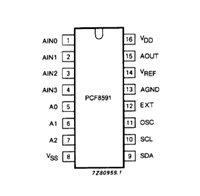ADT7461A
Differences between the ADT7461A and the ADT7461
Series Resistance Cancellation
Although the ADT7461A is pin− and register−compatible
with the ADT7461, there are some specification differences
between the two devices. A summary of these differences is
shown below in Table 1.
Parasitic resistance to the D+ and D− inputs to the
ADT7461A, seen in series with the remote diode, is caused
by a variety of factors, including PCB track resistance and
track length. This series resistance appears as a temperature
offset in the remote sensor’s temperature measurement. This
error typically causes a 0.5°C offset per ohm of parasitic
resistance in series with the remote diode.
Table 1. Differences Between the ADT7461A
and the ADT7461
The ADT7461A automatically cancels the effect of this
series resistance on the temperature reading, giving a more
accurate result, without the need for user characterization of
this resistance. The ADT7461A is designed to automatically
cancel typically up to 1.5 kW of resistance. By using an
advanced temperature measurement method, this process is
transparent to the user. This feature permits resistances to be
added to the sensor path to produce a filter, allowing the part
to be used in noisy environments. See the section on Noise
Filtering for more details.
Specification
Supply Voltage
ADT7461A
3.0 to 3.6
1.0
ADT7461
3.0 to 5.5
3.0
Unit
V
Maximum Local Sensor
Accuracy
°C
Maximum Series
Resistance Cancellation
1.5
3.0
kW
mA
Average Operating
Supply Current
16 Conversions/Sec
Standby Mode
240
5.0
170
5.5
Max Conversion Time
One Shot, Averaging On
One Shot, Averaging Off
ms
52
8.0
114.6
12.56
Temperature Measurement Method
A simple method of measuring temperature is to exploit
the negative temperature coefficient of a diode, measuring
Remote Sensor Current
mA
Levels
High
Mid
the base emitter voltage (V ) of a transistor operated at
BE
220
82
13.5
96
36
6.0
constant current. However, this technique requires
Low
calibration to null the effect of the absolute value of V
which varies from device to device.
,
BE
The technique used in the ADT7461A measures the
Theory of Operation
change in V when the device operates at three different
The ADT7461A is a local and remote temperature sensor
and over/under temperature alarm, with the added ability to
automatically cancel the effect of 1.5 kW (typical) of
resistance in series with the temperature monitoring diode.
When the ADT7461A is operating normally, the on−board
ADC operates in a free running mode. The analog input
multiplexer alternately selects either the on−chip
temperature sensor to measure its local temperature or the
remote temperature sensor. The ADC digitizes these signals
and the results are stored in the local and remote temperature
value registers.
The local and remote measurement results are compared
with the corresponding high, low, and THERM temperature
limits, stored in eight on−chip registers. Out−of−limit
comparisons generate flags that are stored in the status
register. A result that exceeds the high temperature limit or
the low temperature limit causes the ALERT output to
assert. The ALERT output also asserts if an external diode
fault is detected. Exceeding the THERM temperature limits
causes the THERM output to assert low. The ALERT output
can be reprogrammed as a second THERM output.
BE
currents. Previous devices used only two operating currents,
but it is the use of a third current that allows automatic
cancellation of resistances in series with the external
temperature sensor.
Figure 14 shows the input signal conditioning used to
measure the output of an external temperature sensor. This
figure shows the external sensor as a substrate transistor, but
it can equally be a discrete transistor. If a discrete transistor
is used, the collector is not grounded but is linked to the base.
To prevent ground noise interfering with the measurement,
the more negative terminal of the sensor is not referenced to
ground, but is biased above ground by an internal diode at
the D− input. C1 may be added as a noise filter (a
recommended maximum value of 1000 pF). However, a
better option in noisy environments is to add a filter, as
described in the Noise Filtering section. See the Layout
Considerations section for more information on C1.
To measure DV , the operating current through the
BE
sensor is switched among three related currents. As shown
in Figure 14, N1 x I and N2 x I are different multiples of the
current, I. The currents through the temperature diode are
The limit registers are programmed and the device
controlled and configured via the serial SMBus. The
contents of any register are also read back via the SMBus.
Control and configuration functions consist of switching
the device between normal operation and standby mode,
selecting the temperature measurement range, masking or
enabling the ALERT output, switching Pin 6 between
ALERT and THERM2, and selecting the conversion rate.
switched between I and N1 x I, giving DV ; and then
BE1
between I and N2 x I, giving DV . The temperature is then
BE2
calculated using the two DV measurements. This method
BE
also cancels the effect of any series resistance on the
temperature measurement.
The resulting DV waveforms are passed through a
BE
65 kHz low−pass filter to remove noise and then to a
http://onsemi.com
7






 STM32F030C6芯片介绍:主要参数分析、引脚配置说明、功耗及封装
STM32F030C6芯片介绍:主要参数分析、引脚配置说明、功耗及封装

 PCF8591数据手册解读:参数、引脚说明
PCF8591数据手册解读:参数、引脚说明

 一文带你了解ss8050参数、引脚配置、应用指南
一文带你了解ss8050参数、引脚配置、应用指南

 深入解析AD7606高性能多通道模数转换器:资料手册参数分析
深入解析AD7606高性能多通道模数转换器:资料手册参数分析
